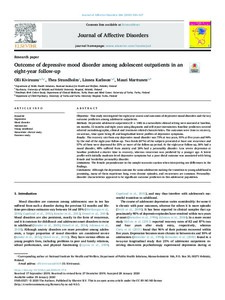Outcome of depressive mood disorder among adolescent outpatients in an eight-year follow-up
Kiviruusu O; Strandholm T; Marttunen M; Karlsson L
https://urn.fi/URN:NBN:fi-fe2021042826302
Tiivistelmä
Objectives
This study investigated the eight-year course and outcomes of depressive mood disorders and the key outcome predictors among adolescent outpatients.
Methods
Depressive adolescent outpatients (N = 148) in a naturalistic clinical setting were assessed at baseline, six months, 12 months and eight years using diagnostic and self-report instruments. Baseline predictors covered selected sociodemographic, clinical and treatment-related characteristics. The outcomes were time to recovery, recurrence, time spent being ill and longitudinal latent profiles of depressive symptoms.
Results
The recovery rate from any depressive mood disorder was 73% at two years, 91% at five years and 94% by the end of the eight-year follow-up. Two thirds (67%) of the subjects presented at least one recurrence and 57% of them were depressed for 25% or more of the follow-up period. At the eight-year follow-up, 36% had a mood disorder, 48% suffered from anxiety and 26% had a personality disorder. Less severe depression at baseline predicted a shorter time to recovery, whereas recurrence was predicted by a younger age. A latent profile with initially moderate-level depressive symptoms but a poor distal outcome was associated with being female and borderline personality disorder.
Limitations
The female preponderance in the sample warrants caution when interpreting sex differences in the findings.
Conclusions
Although the depression outcome for some adolescents making the transition to young adulthood is promising, many of them experience long, even chronic episodes, and recurrences are common. Personality-disorder characteristics appeared to be significant outcome predictors in this adolescent population.
Kokoelmat
- Rinnakkaistallenteet [19207]
